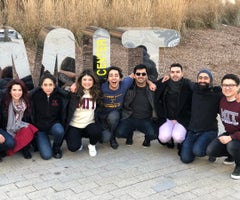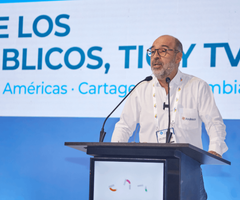
En el Massachusetts Institute of Technology de EE.UU. se destacan 43 colombianos
The US alone accounts for 18.000 Colombian students
According to Migración Colombia (immigration control authority) 73.740 Colombians left their home country to follow an educational opportunity in the nine month span between January and October of 2018. Two of the most popular destinations for Colombian students, educators and researchers are the United States and Spain. The US alone accounts for 18.000 Colombian students, of which 43 have made their way to the classrooms and research centers of the Massachusetts Institute of Technology (MIT), where they stand out due to their talent and leadership. We interviewed 15 of these brilliant minds and hope to get to the rest of this unique group in the near future.
Why study at MIT?
MIT is one of the world’s top research universities. It preaches at the highest levels of science, technology and liberal arts from its Cambridge, Massachusetts campus, training its students to pursue disruptive changes and solutions to the world’s problems. MIT’s faculty includes nine Nobel and two Pulitzer Prize recipients, as well as a long list of publicly renown researchers. But maybe what sets the Institute apart is its commitment to open, borderless, shared learning. This vision can be perceived everywhere and at all times, as the campus remains completely open to the public, with little restriction to attend classes or identification requirements to enter libraries. Software is free and every advancement is shared with the world. MIT understands the true meaning of education: mind and hand to move forward.
Studying at MIT is not impossible
Two of the commonly discussed barriers to study in the US relate to language and financial resources. With respect to the former, we need to work toward high quality bilingual private and public schools throughout the Colombian territory. In relation to the latter, there are a multitude of little-known scholarship opportunities that enable Colombians to study in universities like MIT. There are also various programs that cover tuition fee and provide a stipend for assisting in research or teaching at the university, very much like a salaried job. A majority of doctorate degrees include financial aid for the duration of the program, covering tuition, a stipend and medical insurance. In this way, studying at MIT becomes a question of will and persistence.
Some tips to get accepted:
- Contact university professors regarding your interest in being part of MIT.
- Participate in teaching and research exchange opportunities as a first step. These experiences may enable a prolonged stay.
15 brilliant Colombian minds at MIT

Carlos A. Ríos Ocampo Physicist from the Universidad de Antioquia. Master’s recipient in Optics and Photonics (Europhotonics program of Erasmus Mundus) from the Karlsruhe Institute of Technology. Doctorate in Photonic Materials from Oxford University. His scientific interest lies at the nanoscale interaction between light and matter and in the development of new technologies based on nanomaterials and optoelectronic architecures of chips, such as the neuromophic computation using light. He is currently a Postdoc Associate at MIT.
Foto: Cortesía
Ingrid Mosquera Studied International Relations and Law at the Universidad del Rosario and specialized in Finance and Capital Markets at the Universidad de la Sabana. She has experience in finance, and was a legal manager at BBVA Asset Management. Ingrid is interested in the intersection of law, technology and digital transformation of finance products and FinTech, reason why she left her job to broaden her education at MIT within the Sloan Fellows MBA program. She is a recipient of the “Dean Fellowship,” an award that highlights her professional excellence and achievements which has enabled her studies at MIT. She also participates in the MIT Media Lab DCI – Digital Currency Initiative and the Fintech Ventures program.
Foto: Cortesía
Diego Cifuentes Mathematician and Electronic Engineer from the Universidad de Los Andes where he was a recipient of a full scholarship throughout his undergraduate program. He received a PhD in Electrical Engineering and Computational Science from MIT. Diego left for a postdoctoral fellowship position at the Max-Planck Institute in Leipzig, but returned as an instructor in the Mathematics Department at MIT. His current research relates to relaxation techniques for non-convex optimization problems and semidefinite programming.
Foto: Cortesía
Gladys Vélez Caicedo She is from Zarzal, Valle. Fell in love with the stars when she was three years old. She is an Astrophysicist from Columbia University and is continuing her studies in experimental physics at MIT. She has worked in experimental astrophysics, in particular with particle accelerators and gamma ray telescopes such as Fermi and the VERITAS Institute. She is an instructor within the Physics Department at MIT, where she leads courses that study climate change and provide a foundation in climate science.
Foto: Cortesía
Isabella Loaiza After graduating with a Business Administration degree, she realized this profession was not her true calling. She decided to pivot towards science and work on projects related to societal change. She currently works in computational social science, network science, complex systems, mass migrations and big data. Isabella is developing a project on migration, where she studies the integration of large groups of people to the communities that embrace them. She is also laying the foundations for a system that provides early alarms regarding international conflict through big data. These projects are pursued at the MIT Media Lab where she is a Research Assistant.
Foto: Cortesía
Andrés Felipe Salazar Gómez Biomedical engineer of the Universidad EIA in Colombia. PhD in Computational Neuroscience from Boston University. Currently a Postdoctoral Researcher at the Office of Open Learning at MIT. He was a postdoctoral scholar at the Distributed Robotics Laboratory at MIT, where he explored the use of brain activity to control robots during collaborative human-robot tasks. His research centers in developing brain-machine interfaces that facilitate Augmentative and Alternative Communication for human-robot interactions.
Foto: Cortesía
Catalina Guío Lawyer specialized in financial legislation from the Universidad de Los Andes. She completed a Masters in Law at Harvard University and was the Delegated Superintendent for Mercantile Procedures at the Superintendencia de Sociedades (business superintendency). She participated in the implementation of the Justicia en Linea program that allows citizens to sue and review records through a digital platform. Catalina also led the design and development of an Artificial Intelligence system to resolve corporate litigation cases. At MIT, she is part of the Sloan Fellows MBA program, where she is focused on strategy and innovation for fintech and entrepreneurship.
Foto: Cortesía
David D’Achiardi Studied Mechanical Engineering and Economics at MIT. Upon graduation he worked as a Design Engineer at Tesla’s Gigafactory in Reno, Nevada. He returned to MIT in 2017 to research the integration of renewable energy in the power sector, analyzing the interactions and opportunities with natural gas and transportation networks. David develops transactive control mechanisms for natural gas power plants and electric trains which increase the adoption and utilization of renewable energy and social welfare. He has a strong desire to return to Colombia and contribute to the modernization of energy and transportation systems.
Foto: Cortesía
Diana Gonzáles Electronic engineer from the Escuela Colombiana de Ingeniería Julio Garavito. MS and PhD in Electronic Engineering from Campinas University in Brazil. Diana was appointed Postdoctoral Fellow at the Wireless Technology Laboratory (WissTek) in FEEC-UNICAMP and now holds a Postdoctoral Fellowship role in the Research Laboratory of Electronics (RLE) at MIT. Her research interests include modeling, analysis and simulation of the fading channel with a focus on wideband cooperative communication techniques.
Foto: Cortesía
Pedro Reynolds-Cuéllar Studied Linguistics at the Universidad Nacional. Completed a Master’s degree at the MIT Media Lab, with a project related to human-robot interaction and has continued as a PhD candidate in the Media Arts & Sciences program at the MIT Media Lab. Pedro has experience working in education and technology in Latin America and Africa. He initially arrived at MIT as an instructor and researcher of low-cost technology development targeted at areas with extreme poverty. He is the founder of a low-cost technology design firm in Colombia which focuses on community-based national and international projects.
Foto: Cortesía
Samuel Serna Graduate of the Universidad Nacional. Master’s degree recipient in Photonics of the Friedrich-Schiller-Universitat Jena and in Optics, Matter and Plasma of the Institut d'Optique Graduate School Paris. He states that public education has enabled him to rise to where he is today. Samuel was a French Research Ministry fellowship recipient throughout his doctoral program in which he designed and manufactured passive silicon photonic structures and developed techniques to test and exploit their non-linear, third order susceptibilities. Aa a Postdoctoral Researcher at MIT, he leads a collaboration project between the Nanoscience and Nanotechnology Center of the Université Paris Sud and the Materials Science and Engineering Department at MIT that seeks to exploit new hybrid devices to guide and process light.
Foto: Cortesía
Pablo Cárdenas Studied Biological Sciences at the Universidad de Los Andes and is currently a Junior Scientist within the Biological Engineering Department at MIT. Pablo is proud of his Colombian education which included a field research component. This experience entailed a literal “chase of monkeys in the jungle”. He is particularly interested in infectious diseases, evolution and synthetic biology tools in the context of public health and social welfare. While at MIT, Pablo will build computational and molecular tools that manipulate and decipher the mechanisms employed by infectious diseases such as Malaria.
Foto: Cortesía
César A. Uribe Cucuteño. Electronic Engineer from the Universidad de Antioquia. Recipient of Master’s degrees in Systems and Control from TUDelft and Applied Mathematics from UIUC. Doctoral graduate in Electrical and Computational Engineering. Currently a Postdoctoral Researcher at MIT studying graph topology dynamics in networks. He would like to return to Colombia as a Professor.
Foto: Cortesía
Andrés F. Cubillos Microbiologist from the Universidad de los Andes. Halfway through his degree, Andrés realized that he had a strong passion for research which motivated him to pursue a PhD in Microbiology at MIT. His doctoral research focused on the study of the most abundant photosynthetic bacteria in the oceans, which produces 50% of our planet’s oxygen. He is now a Postdoctoral Researcher at MIT in synthetic biology where he develops synthetic probiotics with genet modifications that enable them to be used for human therapy. Andrés believes that scientific research is fundamental to the development of Colombia, an idea that has encouraged him to create programs that motivate investment in science and intellectual capital development in public schools across the country.
Foto: Cortesía
Andrea Baena Studied Industrial Engineering at the Universidad de Los Andes. She is a Master’s student in the Architecture Department at MIT where she has integrated her research on the design of social housing projects with the topics of informality, climate change and migration. As a leader for the student group Latinx at MIT she has enabled events where members of the community exchange ideas pertaining to fundamental issues in Latin America. Andrea would like to return to Colombia, apply what she has learned at MIT and develop large architectural projects with social impact.
Foto: CortesíaTENDENCIAS
MÁS DE ECONOMÍA
Presidente de Andesco dijo que Colombia no tomará represalias por arancel de EE.UU.
Camilo Sánchez, expuso que en el consejo de ministros se definió una hoja de ruta para atender los impactos del arancel de 10%
Colombia asume presidencia pro-tempore de Celac con idea de integración energética
Gustavo Petro dio un mensaje a los líderes de la región a actuar de manera conjunta y abrirse a nuevas oportunidades comerciales
Se oficializa la candidatura de Laura Gil a la Secretaría General Adjunta de la OEA
Laura Gil dijo que uno de los retos que enfrentará la Organización de Estados Americanos en el futuro cercano será el presupuesto











